Wet Flies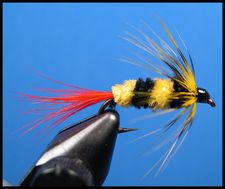 Black Laced McGintyThis is my warmwater version of the classic McGinty wet fly. It's a great panfish fly that's productive throughout the season. Materials List
Tying NotesThe Black Laced McGinty is an easy fly to tie. And that's good because it's a great panfish fly. Tom Keith, author of Fly Tying and Fishing for Panfish & Bass, claims that it's often his go-to fly when nothing else is working. Tom calls his fly the Improved McGinty because he dropped the duck quill wing and brown beard from the original McGinty and replaced them with a yellow hackle collar. I call my fly the Black Laced McGinty because it sports a Black Laced Yellow Hen Neck Feather which, in my opinion, gives the fly much more character. However, the fish don't seem to have a preference. You could substitute a tuft of red rabbit fur for the tail if you don't have a red feather. Use small chenille for the body. It looks much better than medium chenille. If you don't have Uni-Wool for the tapered underbody, you could dub the underbody with some kind of big bug dubbing. Angling TipsIf you're fishing this little fly in the weeds, around wood, or under overhanging tree branches, your're going to occasionally lose the fly. So, use a fairly light tippet so you can break off with minimal effort if you hang up the fly. Tom weights some of his McGinty's. I don't because I think that weight minimizes the fly's action. Instead, I fish all of my underwater flies with a ten foot sink tip line thats been cut back to five feet. It works great and casts easily. To further maximize the fly's action, attach the fly to the leader with a Duncan Knot or Non-Slip Mono Knot. Check out the "On The Water" page to learn how to tie these two great fishing knots. Tying Instructions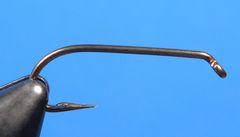 Step 1 Clamp the hook in the vice and crimp the barb. 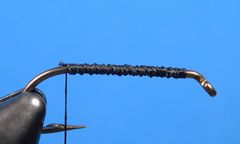 Step 2 Start the thread at the hook's eye and cover the shank with thread back to the hook's bend. 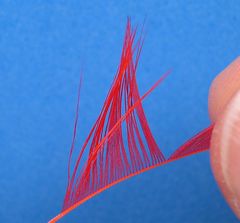 Step 3 Select a hen neck feather, strip away the fluff from the base of the stem, and isolate several barbs to be used for the tail. 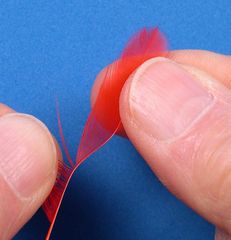 Step 4 Remove the barbs as shown in the photo. 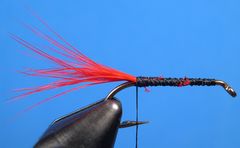 Step 5 Attach the barbs at the hook's bend. They should extend beyond the bend about hook shank length. 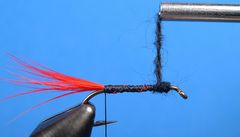 Step 6 Attach the Uni-Wool at the front of the hook and form a tapered underbody back to the tail as illustrated in the next step. 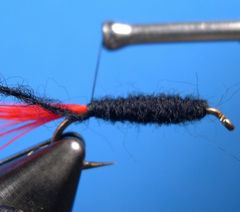 Step 7 Once you are satisfied with the tapered underbody, tie it off as shown in the photo. 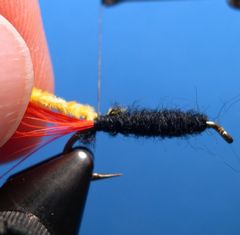 Step 8 Tie in a three-inch piece of yellow chenille at the base of the tail. 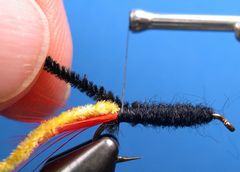 Step 9 Tie in a three-inch piece of black chenille at the same point that you tied in the yellow chenille. 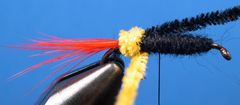 Step 10 Pull the black chenille forward with your right hand as shown and take two full turns of yellow chenille around the shank with your left hand. Let go of the black chenille, take the bobbin and tie off the yellow chenille with a couple of turns of thread. Move the thread forward a bit and prepare to take two turns of black chenille. 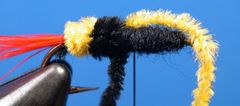 Step 11 Now make a black band by pulling the yellow chenille forward with you right hand. Then take two full wraps of black chenille around the hook shank. Tie off the black chenille with a couple turns of thread in the same way that you tied off the yellow chenille. Move the thread forward a couple of turns in preparation for the next band of yellow chenille. 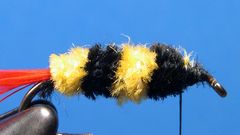 Step 12 Continue tying in alternating bands until you have reached a point about two hook eye widths from the hook eye. Tie off both chenille strands and remove the excess. 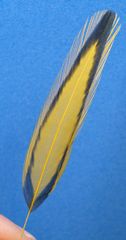 Step 13 Select an appropriate Black Laced Yellow feather from a Whiting American Hen Neck. The barbs on the feather should be long enough to reach the hook point when the feather becomes the collar. 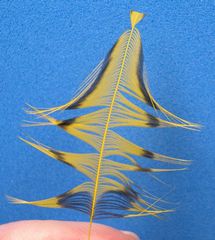 Step 14 Remove the fluff from the base of the stem, stroke back the fibers, and trim the tip of the feather as shown in preparation for tying in the feather. 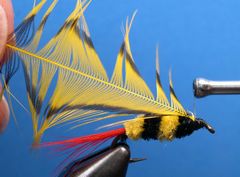 Step 15 Tie in the feather by it's tip with the concave side facing the fly. 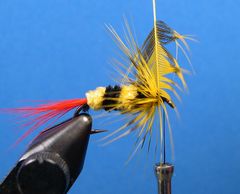 Step 16 Take three or four turns of the feather to form the collar. Leave enough room for the thread head. 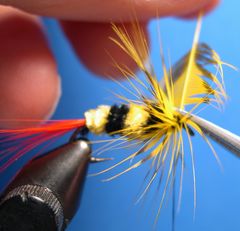 Step 17 Take a couple turns of thread to bind down the stem and remove the excess with your scissors tips. 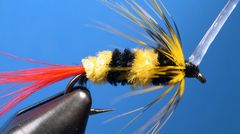 Step 18 Form a neat thread head. Tie off the thread with a couple of half-hitches. Coat the head with head cement. 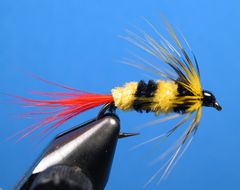 Step 19 Your Black Laced McGinty is finished.
Warmwater Fly Tyer - by Ward Bean
© Copyright 2026 Ward Bean, Council Bluffs, IA, All rights reserved. © Copyright 2026 Ward Bean, Council Bluffs, IA, All rights reserved.
|